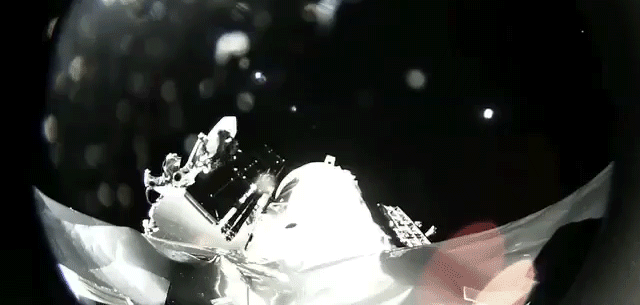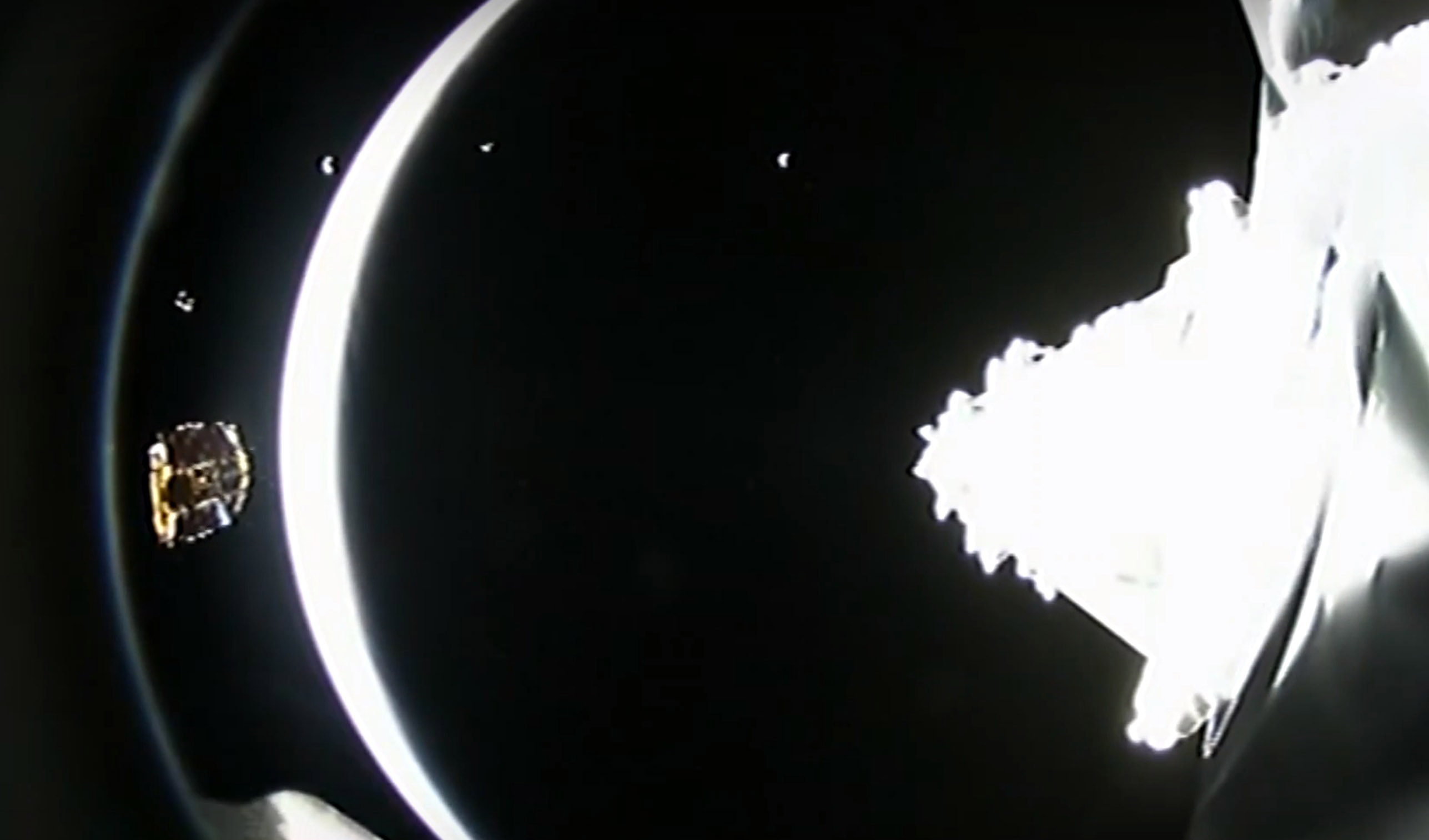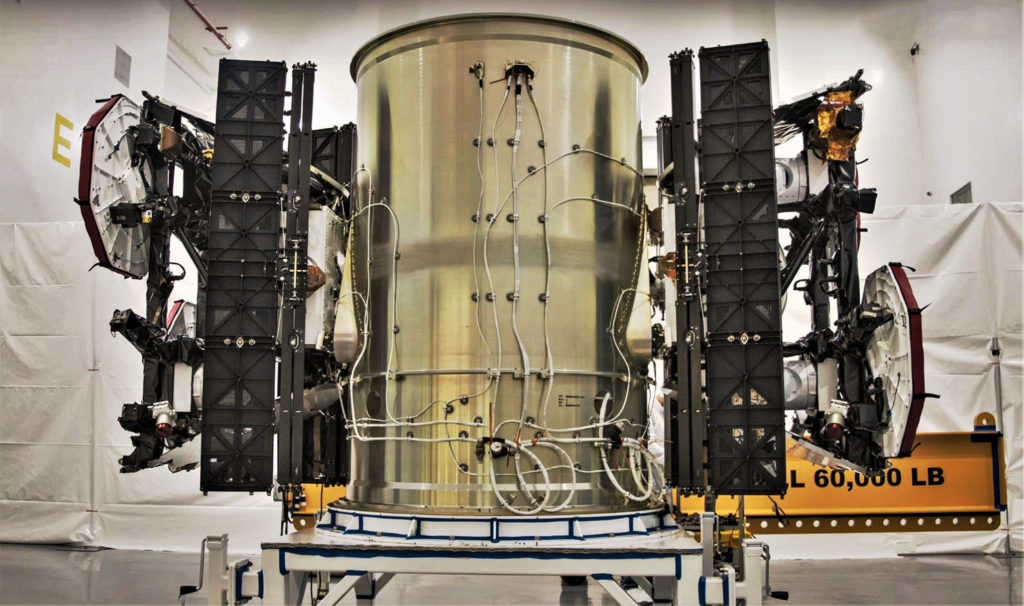

SpaceX
SpaceX job posts hint at building satellite constellations for US military
Published within the last week, unusual SpaceX job postings have begun to combine a range of topics unusual for the company, indicating some level of internal interest in entering into an entirely new industry and mode of operations.
Judging from the job descriptions, SpaceX is looking to hire engineers familiar with integrating third-party payloads onto in-house satellite buses, and they are primarily interested in engineers with Top Secret security clearances.
https://twitter.com/collinkrum/status/1002425606401736704
Given the subtlety of the relevant job postings and the apparent need for high-level security clearances to become involved, it’s extremely difficult to figure out what exactly SpaceX’s goals are. Still, they contain just enough detail to point in the direction of several obvious explanations. These revolve around one industry in particular: satellite operations and sales to or for third parties.
To some extent, these job listings are to be expected: SpaceX has extensive experience building spacecraft (Falcon 9 upper stages and Dragon) explicitly intended for internal use and operations only. Instead, what is surprising about these job listings is the presence of repeated references to “customer payload[s]” in the context of “satellite mission design”, “SpaceX-developed satellite constellations and payload missions”, the “simulation of remote sensing payloads and constellations”, and a need for “on-orbit commissioning” or “activation”.
Put simply, there is no obvious explanation for why SpaceX would need any of those things, at least in the context of the company’s publicly-known activities and business interests. Taken individually, they might be explained by – as described in the same listings – “[SpaceX’s expanding] classified mission manifest”, as it’s well-known that SpaceX is in the process of certifying Falcon 9 and Falcon Heavy to launch all practicable Air Force (USAF) and National Reconnaissance Office (NRO) payloads. Those payloads often need to be placed in high-energy orbits that rely on extended upper stage coasts between orbit-raising maneuvers, essentially requiring modifications to Falcon 9’s upper stage such that it becomes a sort of ad-hoc, short-lived satellite.
- SpaceX’s first Falcon Heavy launch also happened to be a strategic and successful test of Falcon upper stage coast capabilities. (SpaceX)
- SpaceX’s first two Starlink prototype satellites are pictured here before their inaugural launch, showing off a thoroughly utilitarian bus and several advanced components. (SpaceX)
Starlink spinoffs
However, in all (conceivable) cases where SpaceX might launch a highly-classified payload for a government customer, the dynamic is still precisely that – launch provider (SpaceX) and customer (NRO/USAF/etc). Just like FedEx or UPS have no ownership of or relationship with the goods they transport, satellite launch providers are simply delivering a (very expensive, fragile, and irreplaceable) payload from Point A (the ground) to Point B (orbit). When UPS ships a new smartphone from the manufacturer to the customer, they most certainly do not perform an “in-house commissioning” – if the customer needs help setting up their new phone, they go to the manufacturer or service provider (cell carrier).
In the same way, satellite commissioning is a generally necessary process where the satellite manufacturer – rarely the actual operator or service provider – raises or fine-tunes the expensive spacecraft’s orbit and verifies that all systems and payloads are functioning as intended – only after that process is complete does the manufacturer finally ‘hand off’ the satellite to the customer that paid for it. In some cases, the manufacturer continues to maintain or at least monitor the satellite in the background as the owner serves its own customers, much like how military airplane manufacturers are typically contracted to maintain or support those planes even after final delivery.
Judging from the need for top-secret security clearance in nearly all of these new job postings, SpaceX clearly has a very particular sort of customer in mind. Be it DARPA, NRO, the USAF, or some totally unknown government actor, one or several of the above entities have expressed explicit interest in coopting SpaceX’s newfound status as a prospective dirt-cheap-satellite manufacturer. If that were not the case, SpaceX would not be keen to publish 5+ engineering job postings with top-secret clearance as an explicit prerequisite.

Project Blackjack
Ultimately, it’s undeniable that the prospect of a completed vertically-integrated launch and satellite service provider could be so alluring that entities like the NRO, USAF, or DARPA simply could not pass up the opportunity to at least give it a try. From a purely speculative perspective, the services and processes SpaceX seems to be in the middle of developing are an almost perfect fit with DARPA’s (Defense Advanced Research Projects Agency) brand new Blackjack program. Perfectly summarized in September by Space News reporter Sandra Erwin,
“[DARPA] wants to buy small satellites from commercial vendors, equip them with military sensor payloads and deploy a small constellation in low-Earth orbit to see how they perform in real military operations.”
DARPA awarded a $1.5M contract to smallsat manufacturer and operator Blue Canyon on in October 2018, small relative to the program’s roughly $118M budget. DARPA has made clear that it plans to finalize multiple contracts with different prospective satellite designers and operators in order to ensure a competitive environment, fuel growth in a fairly new industry, and pave the way for the final procurement of an experimental constellation of 20 satellites by 2021. If successful, it could completely change the way the entire US government procures national security-related satellites, offering a far faster, cheaper, and more flexible route to set up unique capabilities.
For prompt updates, on-the-ground perspectives, and unique glimpses of SpaceX’s rocket recovery fleet check out our brand new LaunchPad and LandingZone newsletters!
News
SpaceX launches Ax-4 mission to the ISS with international crew
The SpaceX Falcon 9 launched Axiom’s Ax-4 mission to ISS. Ax-4 crew will conduct 60+ science experiments during a 14-day stay on the ISS.

SpaceX launched the Falcon 9 rocket kickstarting Axiom Space’s Ax-4 mission to the International Space Station (ISS). Axiom’s Ax-4 mission is led by a historic international crew and lifted off from Kennedy Space Center’s Launch Complex 39A at 2:31 a.m. ET on June 25, 2025.
The Ax-4 crew is set to dock with the ISS around 7 a.m. ET on Thursday, June 26, 2025. Axiom Space, a Houston-based commercial space company, coordinated the mission with SpaceX for transportation and NASA for ISS access, with support from the European Space Agency and the astronauts’ governments.
The Ax-4 mission marks a milestone in global space collaboration. The Ax-4 crew, commanded by U.S. astronaut Peggy Whitson, includes Shubhanshu Shukla from India as the pilot, alongside mission specialists Sławosz Uznański-Wiśniewski from Poland and Tibor Kapu from Hungary.
“The trip marks the return to human spaceflight for those countries — their first government-sponsored flights in more than 40 years,” Axiom noted.
Shukla’s participation aligns with India’s Gaganyaan program planned for 2027. He is the first Indian astronaut to visit the ISS since Rakesh Sharma in 1984.
Axiom’s Ax-4 mission marks SpaceX’s 18th human spaceflight. The mission employs a Crew Dragon capsule atop a Falcon 9 rocket, designed with a launch escape system and “two-fault tolerant” for enhanced safety. The Axiom mission faced a few delays due to weather, a Falcon 9 leak, and an ISS Zvezda module leak investigation by NASA and Roscosmos before the recent successful launch.
As the crew prepares to execute its scientific objectives, SpaceX’s Ax-4 mission paves the way for a new era of inclusive space research, inspiring future generations and solidifying collaborative ties in the cosmos. During the Ax-4 crew’s 14-day stay in the ISS, the astronauts will conduct nearly 60 experiments.
“We’ll be conducting research that spans biology, material, and physical sciences as well as technology demonstrations,” said Whitson. “We’ll also be engaging with students around the world, sharing our experience and inspiring the next generation of explorers.”
SpaceX’s Ax-4 mission highlights Axiom’s role in advancing commercial spaceflight and fostering international partnerships. The mission strengthens global space exploration efforts by enabling historic spaceflight returns for India, Poland, and Hungary.
News
Starlink Cellular’s T-Mobile service to grow with third-party app data
From Oct 2025, T-Satellite will enable third-party apps in dead zones! WhatsApp, X, AccuWeather + more coming soon.

Starlink Cellular’s T-Mobile service will expand with third-party app data support starting in October, enhancing connectivity in cellular dead zones.
T-Mobile’s T-Satellite, supported by Starlink, launches officially on July 23. Following its launch, T-Mobile’s Starlink Cellular service will enable data access for third-party apps like WhatsApp, X, Google, Apple, AccuWeather, and AllTrails on October 1, 2025.
T-Mobile’s Starlink Cellular is currently in free beta. T-Satellite will add MMS support for Android phones on July 23, with iPhone support to follow. MMS support allows users to send images and audio clips alongside texts. By October, T-Mobile will extend emergency texting to all mobile users with compatible phones, beyond just T-Mobile customers, building on its existing 911 texting capability. The carrier also provides developer tools to help app makers integrate their software with T-Satellite’s data service, with plans to grow the supported app list.
T-Mobile announced these updates during an event celebrating an Ookla award naming it the best U.S. phone network, a remarkable turnaround from its last-place ranking a decade ago.
“We not only dream about going from worst to best, we actually do it. We’re a good two years ahead of Verizon and AT&T, and I believe that lead is going to grow,” said T-Mobile’s Chief Operating Officer Srini Gopalan.
T-Mobile unveiled two promotions for its Starlink Cellular services to attract new subscribers. A free DoorDash DashPass membership, valued at $10/month, will be included with popular plans like Experience Beyond and Experience More, offering reduced delivery and service fees. Meanwhile, the Easy Upgrade promotion targets Verizon customers by paying off their phone balances and providing flagship devices like the iPhone 16, Galaxy S25, or Pixel 9.
T-Mobile’s collaboration with SpaceX’s Starlink Cellular leverages orbiting satellites to deliver connectivity where traditional networks fail, particularly in remote areas. Supporting third-party apps underscores T-Mobile’s commitment to enhancing user experiences through innovative partnerships. As T-Satellite’s capabilities grow, including broader app integration and emergency access, T-Mobile is poised to strengthen its lead in the U.S. wireless market.
By combining Starlink’s satellite technology with strategic promotions, T-Mobile is redefining mobile connectivity. The upcoming third-party app data support and official T-Satellite launch mark a significant step toward seamless communication, positioning T-Mobile as a trailblazer in next-generation wireless services.
News
Starlink expansion into Vietnam targets the healthcare sector
Starlink aims to deliver reliable internet to Vietnam’s remote clinics, enabling telehealth and data sharing.

SpaceX’s Starlink expansion into Vietnam targets its healthcare sector. Through Starlink, SpaceX seeks to drive digital transformation in Vietnam.
On June 18, a SpaceX delegation met with Vietnam’s Ministry of Health (MoH) in Hanoi. SpaceX’s delegation was led by Andrew Matlock, Director of Enterprise Sales, and the discussions focused on enhancing connectivity for hospitals and clinics in Vietnam’s remote areas.
Deputy Minister of Health (MoH) Tran Van Thuan emphasized collaboration between SpaceX and Vietnam. Tran stated: “SpaceX should cooperate with the MoH to ensure all hospitals and clinics in remote areas are connected to the StarLink satellite system and share information, plans, and the issues discussed by members of the MoH. The ministry is also ready to provide information and send staff to work with the corporation.”
The MoH assigned its Department of Science, Technology, and Training to work with SpaceX. Starlink Vietnam will also receive support from Vietnam’s Department of International Cooperation. Starlink Vietnam’s agenda includes improving internet connectivity for remote healthcare facilities, developing digital infrastructure for health examinations and remote consultations, and enhancing operational systems.
Vietnam’s health sector is prioritizing IT and digital transformation, focusing on electronic health records, data centers, and remote medical services. However, challenges persist in deploying IT solutions in remote regions, prompting Vietnam to seek partnerships like SpaceX’s.
SpaceX’s Starlink has a proven track record in healthcare. In Rwanda, its services supported 40 health centers, earning praise for improving operations. Similarly, Starlink enabled remote consultations at the UAE’s Emirati field hospital in Gaza, streamlining communication for complex medical cases. These successes highlight Starlink’s potential to transform Vietnam’s healthcare landscape.
On May 20, SpaceX met with Vietnam’s Ministry of Industry and Trade, announcing a $1.5 billion investment to provide broadband internet, particularly in remote, border, and island areas. The first phase includes building 10-15 ground stations across the country. This infrastructure will support Starlink’s healthcare initiatives by ensuring reliable connectivity.
Starlink’s expansion in Vietnam aligns with the country’s push for digital transformation, as outlined by the MoH. By leveraging its satellite internet expertise, SpaceX aims to bridge connectivity gaps, enabling advanced healthcare services in underserved regions. This collaboration could redefine Vietnam’s healthcare infrastructure, positioning Starlink as a key player in the nation’s digital future.
-

 Elon Musk1 week ago
Elon Musk1 week agoTesla investors will be shocked by Jim Cramer’s latest assessment
-

 Elon Musk18 hours ago
Elon Musk18 hours agoxAI launches Grok 4 with new $300/month SuperGrok Heavy subscription
-

 Elon Musk3 days ago
Elon Musk3 days agoElon Musk confirms Grok 4 launch on July 9 with livestream event
-

 News7 days ago
News7 days agoTesla Model 3 ranks as the safest new car in Europe for 2025, per Euro NCAP tests
-

 Elon Musk2 weeks ago
Elon Musk2 weeks agoA Tesla just delivered itself to a customer autonomously, Elon Musk confirms
-

 Elon Musk1 week ago
Elon Musk1 week agoxAI’s Memphis data center receives air permit despite community criticism
-

 Elon Musk2 weeks ago
Elon Musk2 weeks agoTesla’s Omead Afshar, known as Elon Musk’s right-hand man, leaves company: reports
-

 News2 weeks ago
News2 weeks agoXiaomi CEO congratulates Tesla on first FSD delivery: “We have to continue learning!”



















